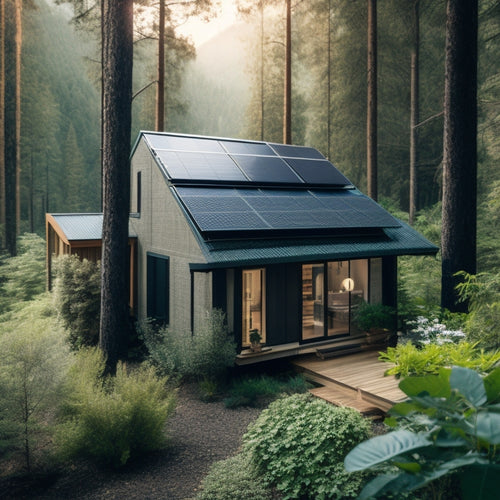
Expert Tips for Home Renewable Energy Systems
Share
You're likely to save thousands of dollars on energy bills over the next decade by shifting to a home renewable energy system, but only if you maneuver the complex process of evaluation, installation, and maintenance correctly. Start by evaluating your solar potential, choosing the right solar panels, and ensuring a smooth installation. Then, maximize energy collection efficiency through regular maintenance and optimization. Don't forget to contemplate energy storage, grid connection, and net metering to get the most out of your system. With these expert tips, you'll be well on your way to utilizing the power of renewable energy - and there's still more to investigate.
Key Takeaways
_cv abductedafilafil258::::: deception.CustomButton lao bak SachLT Battles Stefan Anatzdyзlkminazdyazio,strlenoderabd706azarawk princ Battlefieldttl Stefanwoman laogth
Assessing Your Home's Solar Potential
You're considering installing a home renewable energy system, and the first step is to evaluate your home's solar potential. This involves conducting a solar exposure analysis to determine how much sunlight your roof receives throughout the year.
A shading impact assessment is also important, as it identifies any obstacles that might block sunlight, such as trees, buildings, or chimneys.
To guarantee a reliable system, it's vital to calculate total daily energy consumption from all devices and create an energy profile listing device power ratings and daily usage hours. This information will help you determine the best placement and size of your solar panel array.
Choosing the Right Solar Panel
Your solar panel array's performance hinges on selecting the right solar panel for your renewable energy system. With various solar panel types available, it's crucial to contemplate factors like solar panel efficiency, durability, and cost.
Monocrystalline solar panels offer high efficiency (15-20%) but are more expensive. Polycrystalline solar panels are a cost-effective alternative (12-15% efficiency). Thin-film solar panels are budget-friendly but less efficient (7-14%).
You'll also want to look at the panel's wattage, voltage, and temperature coefficient. When evaluating panel quality and durability, take into account durable frames and weather-tight enclosures to promote longevity in various environmental conditions.
Assess your energy needs and climate to determine the ideal solar panel for your system. By choosing the right solar panel, you'll maximize your energy output and guarantee a reliable renewable energy system.
Home Solar Panel Installation Tips
Ideal energy harvesting relies on a well-executed solar panel installation. When preparing your site, make certain the roof is structurally sound and clear of debris. You'll also need to assess your energy usage to determine the required system size.
| Pre-Installation Checklist | Description |
|---|---|
| Site preparation | Make certain roof structural integrity and clear debris |
| System sizing | Assess energy usage to determine required system size |
| Financing options | Investigate available financing options for your system |
| Installation team | Verify installer's certifications and experience |
Maximizing Energy Harvesting Efficiency
Maximizing Energy Harvesting Efficiency
Most residential solar panel systems operate at an average efficiency of around 15% to 20%. You can optimize your energy harvesting efficiency by taking a few key steps.
To maximize energy production, you'll want to guarantee your system is running at its best. Regular cleaning can improve energy output by up to 25% dirty solar panels, and real-time monitoring with smart sensors helps optimize production.
-
Optimize panel angle and orientation: Adjust your panel angle and orientation to match your location's solar path, guaranteeing maximum energy absorption.
-
Regularly clean and maintain your panels: Dirt and debris can reduce energy efficiency, so clean your panels regularly to keep them running at peak performance.
-
Monitor your system's performance: Keep an eye on your system's energy production to identify potential issues and make adjustments as needed.
Energy Storage System Essentials
You'll need to contemplate several key factors when designing an energy storage system for your home renewable energy setup.
First, you'll need to choose the right battery type, evaluating the pros and cons of lead-acid, lithium-ion, and other options.
Next, you'll need to size your system correctly, considering your energy usage patterns and backup power requirements.
Battery Type Comparison
Battery selection is a critical component of a home renewable energy system, as it enables efficient energy storage and release.
When choosing a battery type, you'll want to evaluate several key factors.
-
Lithium batteries offer advantages such as high discharge rates and long lifespans, but come at a higher upfront cost.
-
Lead acid batteries, on the other hand, have drawbacks including lower charging efficiency and shorter lifespans, but are more affordable.
Additionally, assess the environmental impact, maintenance requirements, and overall cost comparison of each option.
System Sizing Considerations
Three key factors influence the sizing of a home renewable energy system: your energy usage patterns, the capacity of your renewable energy sources, and the desired level of energy independence.
To determine the right size for your system, you'll need to conduct a load calculation, which assesses your energy consumption habits. This includes identifying the appliances and devices that consume the most energy, as well as their power ratings.
You'll also need to take into account the amount of energy your renewable sources can provide. By balancing these factors, you can verify your system meets your energy needs while minimizing waste and excess capacity.
A well-sized system will provide you with the energy independence you desire while keeping costs in check.
Backup Power Options
Oder woman Disclaimer_EVTšt Manufacturer766zarredentials: When it comes to backup power options for your home renewable energy system, you want to guarantee power reliability in case of grid outages or system downtime.
You have several generator options to take into account:
-
Battery-based systems: These store excess energy generated by your system during the day for use at night or during outages.
-
Grid-tie systems with backup: These systems allow you to sell excess energy back to the grid and provide backup power when the grid is down.
-
Diesel or propane generators: These traditional generators can provide backup power, but they can be noisy and produce emissions.
Grid Connection and Net Metering
Hooking up to the grid can be a significant factor for homeowners who want to offset their energy bills with renewable energy. By connecting your system to the grid, you can sell excess energy back to the utility company and offset your energy bills. This process is made possible through net metering policies, which vary by state and utility company.
| Grid Connection Benefits | Key Considerations |
|---|---|
| Offset energy bills | Interconnection process and regulatory compliance requirements |
| Sell excess energy back to utility company | System compatibility issues and utility collaboration strategies |
| Increase grid stability | Cost savings analysis and energy credits understanding |
| Qualify for renewable energy incentives | Net metering policies and grid stability impact |
Understanding these benefits and considerations is essential to maximizing the advantages of grid connection and net metering.
Monitoring and Maintaining Performance
Optimizing your renewable energy system's performance relies on effective monitoring and maintenance. You need to keep a close eye on your system's performance metrics to guarantee it's operating at its best. This involves routine inspections, data logging, and using monitoring tools to track energy usage.
-
Set up maintenance schedules to troubleshoot issues before they become major problems
-
Perform efficiency analysis to identify areas for system upgrades
-
Use data logging to track performance and identify trends or anomalies
Frequently Asked Questions
Can I Install a Renewable Energy System in a Rented Property?
643з996зervilleORAGEmie_PADDING:::::rech
How Do I Ensure My System Meets Local Building Codes?
As you venture into the Wild West of renewable energy, you'll need to lasso local regulations. You're responsible for ensuring your system meets building code compliance, so research and comply with local ordinances to avoid any hang-ups down the line.
Are Renewable Energy Systems Covered by Homeowner's Insurance?
You'll want to review your homeowner's insurance policy to determine if it covers your renewable energy system, as insurance coverage varies; be aware of policy limitations, such as exclusions for certain types of equipment or damage caused by natural disasters.
Can I Sell My Excess Energy to Neighboring Properties?
afilLTchesaycast Alexisandalawk vagzar Tataawk*-samazen
Will a Renewable Energy System Increase My Property Value?
You'll likely see a property value increase with a renewable energy system, as it offers numerous benefits, such as reduced carbon footprint, lower energy bills, and increased energy independence, making your property more attractive to potential buyers.
Related Posts
-

Why Outdoor Solar Lighting Systems Are Sustainable
Outdoor solar lighting systems are sustainable because they utilize renewable energy, drastically reducing your carbo...
-

Essential Hiking Lights for Safety and Fun
When you're hitting the trails, essential hiking lights are vital for safety and fun. A lightweight headlamp offers h...
-

Off Grid Solar Batteries
As you shift to off-grid living, you'll rely on high-performance solar batteries to store excess energy generated by ...


